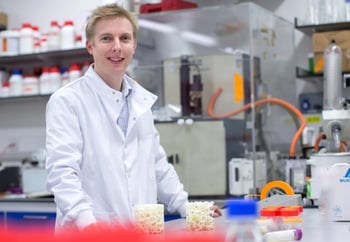An interview with Professor Julian Jones, Professor of Biomaterials and Tissue Engineering, Imperial College London.
In the field of regenerative medicine, there is an unmet clinical need for scaffolds that are capable of load sharing alongside host tissue, whilst biodegrading at a predictable rate under the action of enzymes present at the implant site. Currently scaffolds biodegrade at an uncontrolled rate under the action of water in the body.

If scientists can find a solution, it will create entirely new surgical procedures, such as complex bone, cartilage and ligament reconstructive procedures, including those at sites under cyclic loads. Research is already underway to tackle this clinical deficit.
Makevale spoke to a scientist at the forefront of this research, Professor Julian Jones from Biomaterials and Tissue Engineering, Department of Materials, Imperial College London. Professor Julian provided some exciting insights into his latest research: Enzyme degradable star polymethacrylate/silica hybrid inks for 3D printing of tissue scaffolds.
The research, conducted by Professor Julian and his team at Imperial College London, is the first to present enzyme cleavable, polymer-silica sol-gel hybrids that degrade in response to endogenous tissue specific enzymes, that are typical in the natural remodelling of bone.
The potential positive clinical impact of degradable polymer-silica sol-gel hybrids
At present, there are materials that surgeons can use to heal bones, such as Bioglass and synthetic hydroxyapatite ceramics, which assist bones to heal naturally. However, these solutions cannot be used to heal large holes or for the regeneration of sites under cyclic loads.
Professor Julian explains: “Bioglass and hydroxyapatite ceramics are brittle bioceramics, making them inefficient at healing bigger wounds. There are currently no materials that can help regenerate cartilage in our joints, largely because cartilage is not very good at healing itself.
“This is a challenge we are determined to overcome, with hybrid biomaterials that combine the toughness of polymers with the biodegradable benefits of the bioceramics. The intimate fine scale interactions of the components give us unprecedented control over the properties, so we can make them as stiff as bones or as bouncy as cartilage.”
To overcome the brittle properties associated with bioceramics, Professor Julian and his research team developed inorganic/organic hybrid materials that allowed these composites to achieve the full synergies of their component materials. These sol-gel hybrids consist of a co-network of inorganic and organic components and are produced by introducing a polymer into the sol-gel process.
Manipulating the intimate fine scale component interactions in this way has allowed the research team at Imperial College London to create, for the first time, an ink for 3D printing scaffolds which could be capable of helping the body to heal larger, more complex bone, cartilage and ligament injuries even in sites under cyclic loads.
The benefits of controlled RAFT polymerisation techniques
Some of the most prominent advancements in polymer science have arisen from developments of controlled polymerisation techniques. One such technique is reversible addition fragmentation chain transfer (RAFT).
RAFT allows researchers to prepare materials with controlled molecular weight distributions. It also offers versatility in terms of block architecture and functional end-groups, fine tuning of physiochemical properties and as a consequence, their biological properties.
“It is the shape of our polymer that is key,” continues Professor Julian. “Our star shaped polymers allow us to achieve good mechanical properties whilst also making polymers biodegradable.
“More specifically, the core of our stars is enzyme biodegradable. This is important because most biodegradable polymers break down at uncontrolled rates by action of water. This makes it difficult to predict how their properties change.
“An enzyme degradable core will only degrade when exposed to a specific enzyme, such as that found in a particular site in the human body. This essentially allows the body to ‘decide’ whether the biomaterials are taken away or not. A typical example of this is when bone is healed, which is what happens in natural remodelling.”
In addition to RAFT making it possible to create polymers in more complex shapes, it is also known for its ability to make polymers of tightly controlled chain lengths. When the polymers break down in the body, the remaining particles must pass safely through the kidneys and it is these tightly controlled chain lengths that allow scientists to keep the degradation products at a low molecular weight.
Professor Julian adds: “Thanks to the RAFT polymerisation technique, we are able to produce star shaped polymers that give us the mechanical properties we need, but with low molecular weight required for the scaffold degradation.”
The role of MMA in producing enzyme cleavable scaffolds using RAFT polymerisation
To define the star polymers that were central to this research, Professor Julian and his team utilised RAFT polymerisation, using the monomers TMSPMA and MMA.
“Using MMA allowed us to build in 3-(trimethoxysilyl)propyl methacrylate units so that we could bond the polymers to the silica to give enhanced strength,” highlights Professor Julian.
The arms of the stars were 90 mol% MMA and 10 mol% TMSPMA but the TMSPMA was statistically distributed along the arm so that further study could investigate the efficiency of its location on the overall performance outcome of the polymer star.
How significant is this latest research and what are the next steps?
For the first time, researchers have created an enzyme cleavable polymer-silica sol-gel hybrid ink for the 3D printing of scaffolds that degrade in response to endogenous tissue specific enzyme.
This hybrid polymer enables sustained degradation of 10% after two months of exposure to the enzyme, meaning unlike water-dissolvable scaffolds, degradation is controlled and measurable. This is a significant milestone for the field of regenerative medicine and could pave the way for the successful introduction of new pioneering surgeries.
On vital next steps, Professor Julian concludes with: “We need to test the medical devices that we have developed for bone, cartilage and ligament reconstruction surgeries in preclinical trials.”
